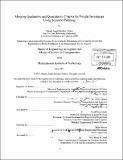| dc.contributor.advisor | Chris Caplice and Mikel Murga. | en_US |
| dc.contributor.author | Sánchez-Valero, Miguel Ángel | en_US |
| dc.contributor.other | Massachusetts Institute of Technology. Dept. of Civil and Environmental Engineering. | en_US |
| dc.date.accessioned | 2012-01-30T17:01:58Z | |
| dc.date.available | 2012-01-30T17:01:58Z | |
| dc.date.copyright | 2011 | en_US |
| dc.date.issued | 2011 | en_US |
| dc.identifier.uri | http://hdl.handle.net/1721.1/68902 | |
| dc.description | Thesis (M. Eng. in Logistics)--Massachusetts Institute of Technology, Engineering Systems Division; and, (S.M. in Transportation)--Massachusetts Institute of Technology, Dept. of Civil and Environmental Engineering, 2011. | en_US |
| dc.description | Cataloged from PDF version of thesis. | en_US |
| dc.description | Includes bibliographical references (p. 164-168). | en_US |
| dc.description.abstract | Freight transportation is vital to the economy of the United States. The total volume of freight moving inside the nation is expected to continue growing, while the U.S. transportation system is aging and becoming more costly to maintain. The revenue streams that allow for its preservation and expansion are decreasing rapidly. Because resources are scarce and long-range consequences difficult to anticipate, great care must be placed in freight transportation investment decisions, a complex process usually involving many stakeholders with diverse interests, modal and jurisdictional silos, diverse and vocal constituents, and a set of final system users that are typically removed from the decision-making process. This thesis explores how freight investment decisions can be helped by the use of scenario planning, a collaborative approach that enhances consensus-building and helps organizations to shift from prediction to preparation for the future, converting uncertainty into a competitive advantage. First, a review of the relevant literature is conducted in order to present a comprehensive description of scenario planning and the transportation planning process. Afterwards, case studies are presented to picture the observed practices in transportation infrastructure planning at different stages of a project lifecycle, followed by a characterization of past and current uses of scenario planning in transportation investment decisions. At that point, a methodology to evaluate alternative investments, strategies or policies under different scenarios is introduced, providing a hypothetical example of use. Finally, a list of recommendations are identified and explained. | en_US |
| dc.description.statementofresponsibility | by Miguel Ángel Sánchez-Valero. | en_US |
| dc.format.extent | 184 p. | en_US |
| dc.language.iso | eng | en_US |
| dc.publisher | Massachusetts Institute of Technology | en_US |
| dc.rights | M.I.T. theses are protected by
copyright. They may be viewed from this source for any purpose, but
reproduction or distribution in any format is prohibited without written
permission. See provided URL for inquiries about permission. | en_US |
| dc.rights.uri | http://dspace.mit.edu/handle/1721.1/7582 | en_US |
| dc.subject | Engineering Systems Division. | en_US |
| dc.subject | Civil and Environmental Engineering. | en_US |
| dc.title | Merging qualitative and quantitative criteria for freight investment using scenario planning | en_US |
| dc.type | Thesis | en_US |
| dc.description.degree | S.M.in Transportation | en_US |
| dc.description.degree | M.Eng.in Logistics | en_US |
| dc.contributor.department | Massachusetts Institute of Technology. Department of Civil and Environmental Engineering | |
| dc.contributor.department | Massachusetts Institute of Technology. Engineering Systems Division | |
| dc.identifier.oclc | 773604111 | en_US |
